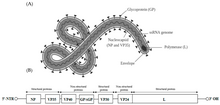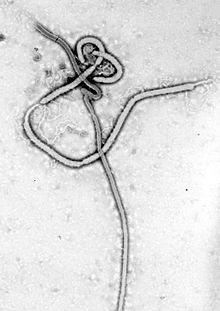
Back Ebolavirus ALS فيروس الإيبولا Arabic ایبولا ویروسی AZB Ebolavirus Catalan Ebolavirus Danish Orthoebolavirus German Ebolavirus Spanish Ebolavirus Estonian Ebolavirus French Ebolafirus Frisian
| Ebolavirus | |
|---|---|

| |
| Structure and genome of the ebolavirus | |

| |
| Ebola virus under transmission electron microscope | |
| Virus classification | |
| (unranked): | Virus |
| Realm: | Riboviria |
| Kingdom: | Orthornavirae |
| Phylum: | Negarnaviricota |
| Class: | Monjiviricetes |
| Order: | Mononegavirales |
| Family: | Filoviridae |
| Genus: | Ebolavirus |
| Species | |

The genus Ebolavirus (/iˈboʊlə/- or /əˈboʊləˌvaɪrəs/; ee-BOH-lə- or ə-BOH-lə-VY-rəs)[1][2][3] is a virological taxon included in the family Filoviridae (filament-shaped viruses), order Mononegavirales.[3] The members of this genus are called ebolaviruses,[3] and encode their genome in the form of single-stranded negative-sense RNA.[4] The six known virus species are named for the region where each was originally identified: Bundibugyo ebolavirus, Reston ebolavirus, Sudan ebolavirus, Taï Forest ebolavirus (originally Côte d'Ivoire ebolavirus), Zaire ebolavirus, and Bombali ebolavirus. The last is the most recent species to be named and was isolated from Angolan free-tailed bats in Sierra Leone.[5] Each species of the genus Ebolavirus has one member virus, and four of these cause Ebola virus disease (EVD) in humans, a type of hemorrhagic fever having a very high case fatality rate. The Reston virus has caused EVD in other primates.[6][7] Zaire ebolavirus has the highest mortality rate of the ebolaviruses and is responsible for the largest number of outbreaks of the six known species of the genus, including the 1976 Zaire outbreak and the outbreak with the most deaths (2014).[8]
Ebolaviruses were first described after outbreaks of EVD in southern Sudan in June 1976 and in Zaire in August 1976.[9][10] The name Ebolavirus is derived from the Ebola River in Zaire (now the Democratic Republic of the Congo), near the location of the 1976 outbreak,[10] and the taxonomic suffix -virus (denoting a viral genus).[3] This genus was introduced in 1998 as the "Ebola-like viruses".[11][12] In 2002, the name was changed to Ebolavirus[13][14] and in 2010, the genus was emended.[3] Ebolaviruses are closely related to marburgviruses.
- ^ American Heritage Dictionary
- ^ Cambridge Advanced Learner's Dictionary
- ^ a b c d e Kuhn, J. H.; Becker, S.; Ebihara, H.; Geisbert, T. W.; Johnson, K. M.; Kawaoka, Y.; Lipkin, W. I.; Negredo, A. I.; Netesov, S. V.; Nichol, S. T.; Palacios, G.; Peters, C. J.; Tenorio, A.; Volchkov, V. E.; Jahrling, P. B. (2010). "Proposal for a revised taxonomy of the family Filoviridae: Classification, names of taxa and viruses, and virus abbreviations". Archives of Virology. 155 (12): 2083–2103. doi:10.1007/s00705-010-0814-x. PMC 3074192. PMID 21046175.
- ^ Kuhn, JH; Amarasinghe, GK; Basler, CF; Bavari, S; Bukreyev, A; Chandran, K; Crozier, I; Dolnik, O; Dye, JM; Formenty, PBH; Griffiths, A; Hewson, R; Kobinger, GP; Leroy, EM; Mühlberger, E; Netesov, SV; Palacios, G; Pályi, B; Pawęska, JT; Smither, SJ; Takada, A; Towner, JS; Wahl, V; ICTV Report, Consortium (June 2019). "ICTV Virus Taxonomy Profile: Filoviridae". The Journal of General Virology. 100 (6): 911–912. doi:10.1099/jgv.0.001252. PMC 7011696. PMID 31021739.
- ^ "New Ebola species is reported for first time in a decade". STAT. 27 July 2018. Retrieved 28 July 2018.
- ^ Spickler, Anna. "Ebolavirus and Marburgvirus Infections" (PDF).
- ^ "About Ebola Virus Disease". Centers for Disease Control. Retrieved 18 October 2014.
- ^ Kamorudeen, Ramat Toyin; Adedokun, Kamoru Ademola; Olarinmoye, Ayodeji Oluwadare (May 2020). "Ebola outbreak in West Africa, 2014–2016: Epidemic timeline, differential diagnoses, determining factors, and lessons for future response". Journal of Infection and Public Health. 13 (7): 956–962. doi:10.1016/j.jiph.2020.03.014. PMID 32475805.
- ^ "Home" (PDF). Archived from the original (PDF) on 2014-10-13. Retrieved 2014-10-07.
- ^ a b Kalra S., Kelkar D., Galwankar S. C., Papadimos T. J., Stawicki S. P., Arquilla B., Hoey B. A., Sharpe R. P., Sabol D., Jahre J. A. The emergence of Ebola as a global health security threat: From 'lessons learned' to coordinated multilateral containment efforts. J Global Infect Dis [serial online] 2014 [cited 2015 Mar 1]; 6:164–177.
- ^ Netesov, S. V.; Feldmann, H.; Jahrling, P. B.; Klenk, H. D.; Sanchez, A. (2000). "Family Filoviridae". In van Regenmortel, M. H. V.; Fauquet, C. M.; Bishop, D. H. L.; Carstens, E. B.; Estes, M. K.; Lemon, S. M.; Maniloff, J.; Mayo, M. A.; McGeoch, D. J.; Pringle, C. R.; Wickner, R. B. (eds.). Virus Taxonomy – Seventh Report of the International Committee on Taxonomy of Viruses. San Diego: Academic Press. pp. 539–548. ISBN 978-0-12-370200-5.
- ^ Pringle, C. R. (1998). "Virus taxonomy – San Diego 1998". Archives of Virology. 143 (7): 1449–1459. doi:10.1007/s007050050389. PMID 9742051. S2CID 13229117.
- ^ Feldmann, H.; Geisbert, T. W.; Jahrling, P. B.; Klenk, H.-D.; Netesov, S. V.; Peters, C. J.; Sanchez, A.; Swanepoel, R.; Volchkov, V. E. (2005). "Family Filoviridae". In Fauquet, C. M.; Mayo, M. A.; Maniloff, J.; Desselberger, U.; Ball, L. A. (eds.). Virus Taxonomy – Eighth Report of the International Committee on Taxonomy of Viruses. San Diego: Elsevier/Academic Press. pp. 645–653. ISBN 978-0-12-370200-5.
- ^ Mayo, M. A. (2002). "ICTV at the Paris ICV: results of the plenary session and the binomial ballot". Archives of Virology. 147 (11): 2254–2260. doi:10.1007/s007050200052. S2CID 43887711.
© MMXXIII Rich X Search. We shall prevail. All rights reserved. Rich X Search